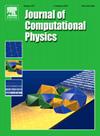Numerical simulation of dilute polymeric fluids with memory effects in the turbulent flow regime
IF 3.8
2区 物理与天体物理
Q2 COMPUTER SCIENCE, INTERDISCIPLINARY APPLICATIONS
引用次数: 0
Abstract
We address the numerical challenge of solving the Hookean-type time-fractional Navier–Stokes–Fokker–Planck equation, a history-dependent system of PDEs defined on the Cartesian product of two d-dimensional spaces in the turbulent regime. Due to its high dimensionality, the non-locality with respect to time, and the resolution required to resolve turbulent flow, this problem is highly demanding.
To overcome these challenges, we employ the Hermite spectral method for the configuration space of the Fokker–Planck equation, reducing the problem to a purely macroscopic model. Considering scenarios for available analytical solutions, we prove the existence of a Hermite scaling parameter, which exactly reproduces the analytical polymer stress tensor. With this choice, the macroscopic system is equivalent to solving the coupled micro-macro system. We apply second-order time integration and extrapolation of the coupling terms, achieving, for the first time, convergence rates for the fully coupled time-fractional system independent of the order of the time-fractional derivative.
Our efficient implementation of the numerical scheme allows turbulent simulations of dilute polymeric fluids with memory effects in two and three dimensions. Numerical simulations show that memory effects weaken the drag-reducing effect of added polymer molecules in the turbulent flow regime.
求助全文
约1分钟内获得全文
求助全文
来源期刊

Journal of Computational Physics
物理-计算机:跨学科应用
CiteScore
7.60
自引率
14.60%
发文量
763
审稿时长
5.8 months
期刊介绍:
Journal of Computational Physics thoroughly treats the computational aspects of physical problems, presenting techniques for the numerical solution of mathematical equations arising in all areas of physics. The journal seeks to emphasize methods that cross disciplinary boundaries.
The Journal of Computational Physics also publishes short notes of 4 pages or less (including figures, tables, and references but excluding title pages). Letters to the Editor commenting on articles already published in this Journal will also be considered. Neither notes nor letters should have an abstract.
 求助内容:
求助内容: 应助结果提醒方式:
应助结果提醒方式:


